Nature's Best :: Don Smith Photography
Exploring our incredible world one image at a time!
Grand Teton Photo Workshop :: September 28 – October 2
Posted on May 26, 2014
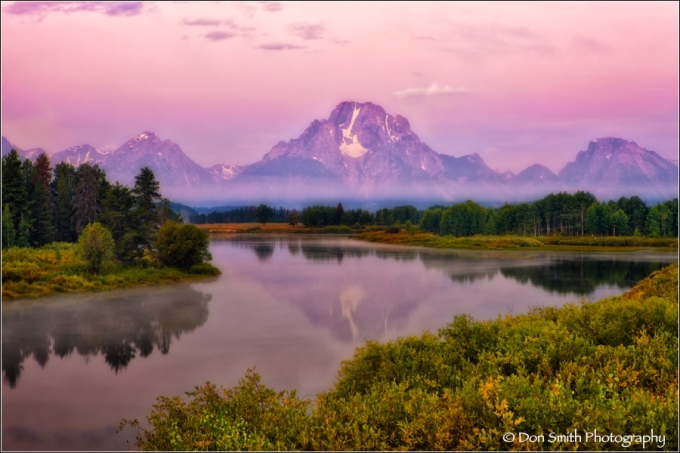
Dawn’s Hues, Oxbow Bend, Grand Teton National Park, Wyoming
Canon 1DsMKIII, 70mm, f/16, 4 seconds, ISO 100, Singh-Ray Thin LB Polarizer, Lexar Digital Media
Join me, along with Scott Schilling and Pierre Steenberg for my 3rd Annual Fall in Grand Teton National Park Workshop this September 28 – October 2, 2014.
Come photograph one of America’s grandest National Parks in one spectacular fall workshop. The aspens and cottonwoods will be at or near peak color with the dramatic sweep of the Grand Teton Range and the iconic Snake River serving as a backdrop.
Above is just one sample of the breathtaking beauty that you will see and photograph. This image was captured at dawn at famed Oxbow Bend.
Words simply won’t do this justice, so I thought I’d let some images do the talking.

Stormy Evening, Snake River Overlook, Grand Teton National Park, Wyoming
Canon 1DsMKIII, 32mm, f/11, 2.5 seconds, ISO 200, Singh-Ray Thin LB Polarizer, Lexar Digital Media
The Snake River Overlook was made iconic by none other than Ansel Adams. Though the trees have grown concealing the actual bend, the beauty is still exquisite. The cottonwoods to the west of the river should be showing their beautiful yellows during the workshop.
I captured this image after sunset with Mike Hall when all the other photographers had left – amazing what they missed!
As you can see in both this image and the next, snows come early in the Grand Teton range. This provides even another layer of beauty to this already amazing area.
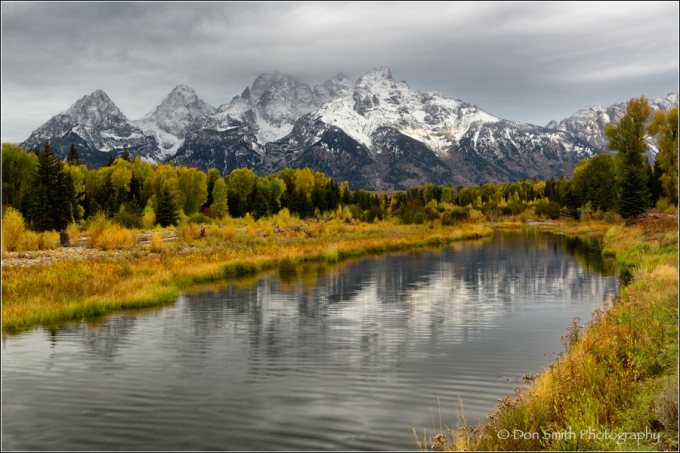
First Light at Schwabacher’s Landing, Grand Teton National Park, Wyoming
Canon 5DMKIII, 44mm, f/16, 1/4 sec., 200 ISO, Singh-Ray Thin LB Polarizer, Lexar Digital Media
We will shoot early at iconic Schwabacher’s Landing. There are so many compositional possibilities that it will boggle your mind – simply gorgeous is the only way I can describe the location.
Just to the north of this scene are the famed beaver ponds and I’ll have you on-location very early to stake your spot.
If we get lucky, the models just may show up on time. My workshop group captured this scene on the way to Oxbow Bend for a sunset shoot (below).
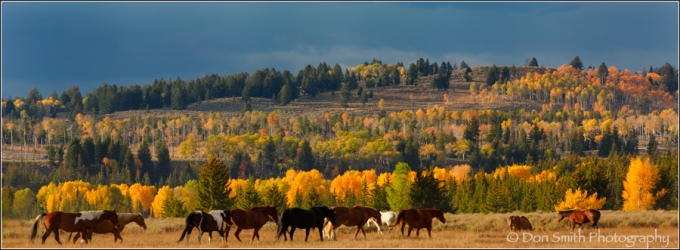
Wild Horses and Fall Color, Grand Teton National Park, Wyoming
Canon 5DMKIII, 190mm, f/8, 1/80th, 100 ISO, Singh-Ray CC Polarizer, Lexar Digital Media
When we are not out photographing, we will be holding daily class sessions dealing with workflow and vision.
As my workshop description states: This workshop will have an emphasis on field location shooting. It will also include two sessions of Photoshop training and a minimum of two image review sessions. Workflow training will include: RAW processing in using the latest version of Lightroom and complete workflow training in the latest version of Photoshop. Workflow topics will include: preparing an image for both print and web presentation, proper methods of setting white and black points, how to “properly massage the middle tones,” color balance, localized tonal and color adjustments via luminosity masking, 32-bit blending techniques, blending multiple exposures via layers and masks, freehand masking techniques, section of masks based on both tones and colors, proper sharpening and noise reduction techniques, etc.

Moulton Barn and Grand Tetons, Grand Teton National Park, Wyoming
Canon 1DsMKIII, 25mm, f/16, 2 seconds, ISO 200, Singh-Ray Thin LB Polarizer, Singh-Ray 2 stop soft edge GND, Lexar Digital Media
Of course we will spend one sunrise and perhaps one afternoon photographing along famous Mormon Row. The Moulton Barn is an iconic scene with the Teton Range serving as a backdrop and is a symbol of the west’s grandeur.
So I hope you can join in. There are (6) spots remaining as of this writing. For more information, please click here: Fall In Grand Teton National Park :: September 28 – October 2, 2014. You can also email me for more information:don@donsmithphotography.com.
Free Video Sample :: Chapter 19 – Introduction to Luminosity Masks
2014 Photo Workshops – Complete List
2015 Photo Workshops
Software Discounts
Photomatix Pro 4.2 type in code at checkout: donsmithphotography 15% discount
Topaz Software type in code at checkout: SMITHPHOTO 10% discount
Helicon Focus click on link to receive 15% discount
Hardware Discounts
MindShift Gear rotation180° Panorama rotating day hiker backpack
Robert’s Distributors – 10% off any regularly priced camera bag and a free memory card wallet with any purchase. Call John or Nick at 800-726-5544 and reference you saw this posted on my blog site.
My Favorite 12 Images Of 2013!
Posted on December 22, 2013
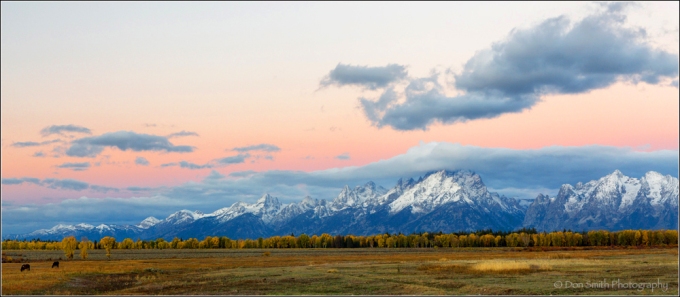
Image #10 – Dawn, Grand Teton National Park, Wyoming
Canon 5DMKIII, 50mm, f/16, 1.3 sec., ISO 100, Singh-Ray Slim LB Polarizer
My 10th favorite image of the year came about quite by accident. On this particular morning, my Grand Teton workshop group departed Jackson for Oxbow Bend. My co-instructors, Scott Schilling, Pierre Steenberg and I were in the last car following the group.
As we approached the Moran gate, a young ranger put up his hand for us to stop. I saw he had four large orange cones near his booth. As I rolled down the window, he said the park was officially closed due to the government’s inability to reach a budget settlement hours earlier.
I proceeded to plead with him that we were workshop instructors with a valid Commercial Use Authorization permit and that our group was just up the road awaiting sunrise. He apologized, but said we would have to turn around.
Scott made a quick phone call to one of our group members alerting them what had happened and we headed back towards Jackson and stopped to photograph this scene near Triangle X Ranch. I made this image about 10 minutes before actual sunrise and loved the juxtaposition of the morning hues against the fall color of the cottonwoods in the distance.
Our group had great light at Oxbow Bend, and we completed the workshop at awesome locations outside of the park (some that will remain in the lineup for next year’s workshops)!

Image # 11 – Winter Sunset at Garrapata State Beach
Canon 5DMKIII, 44mm, f/16, 1/10th sec., ISO 200, Singh-Ray Slim Polarizer
My 11th favorite image of the year was captured in early February while teaching a private lesson and shooting a sunset at Big Sur’s Garrapata State Beach. The sun had actually set and the color on the horizon had momentarily disappeared. I cautioned my client to not be so quick to pack as we had an extremely clear horizon that evening.
As the sun sank lower below the horizon, it cast warm rays up and under this stratus cloud that was hanging along the shoreline. We quickly moved in front of this rock to anchor the foreground and the light on the cloud became incredibly rich and saturated.
Generally speaking, one does not often see this type of saturated light after sunset on the coast. This light is more often seen in the mountains; yet, on this evening, we got one heck of a show!
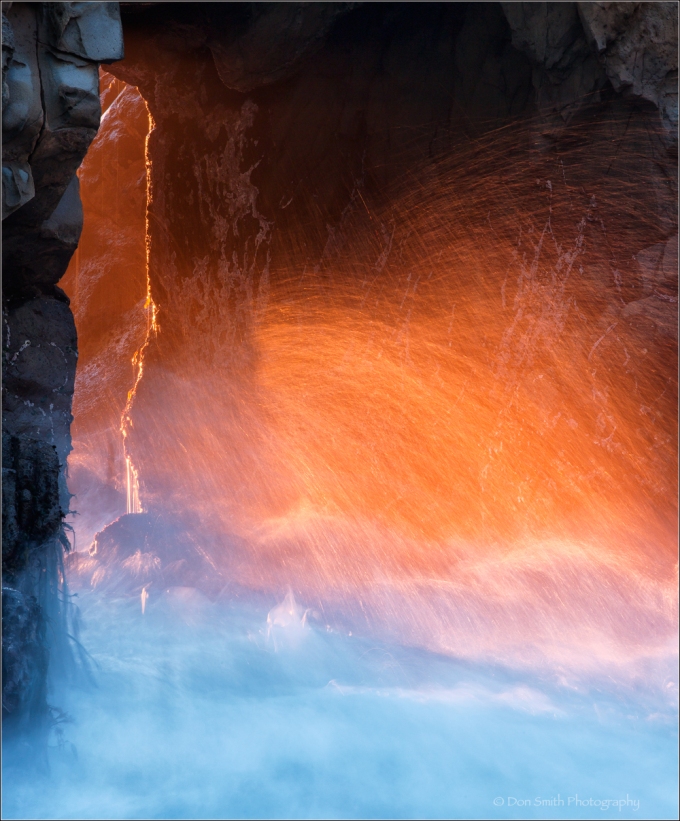
Image #12 – Devil’s Cauldron, Pfeiffer Arch
Canon 5DMKIII, 200mm, f/22, 2.0 sec., 200 ISO, Singh-Ray CC Polarizer
Today I start with Image #12, that I captured last week at Pfeiffer Arch along the Big Sur coast. This image is both exciting and sad, as a day after I captured this scene, the Big Sur Pfeiffer Ridge fire broke out along the mountain ridge across from this arch. As I write this, firefighters expect full containment (today), but 34 homes were destroyed.
During December and January, on a clear-sky day, the setting sun aligns with the opening of the arch and allows for this incredible warm light to spill through the opening. One must time the wave surging through the arch. As the mist from the funneled water rises, it is backlit by the sun.
I personally try for a different approach each time I’m at the arch. On this particular evening, the color was gorgeous and I decided to try a tight shot with a 200mm. This was my second to last frame before the sun finally set allowing for the intense warm color.
Sadly, for all those who lost their homes in the Pfeiffer fire, our thoughts and prayers go out to you.
2014 Photo Workshops – Complete List
5th Annual Kauai Workshop – Garden Isle and Tropical Paradise – June 20-24, 2014 (3 spots remaining)
Software Discounts
Photomatix Pro 4.2 type in code at checkout: donsmithphotography 15% discount
Topaz Software type in code at checkout: SMITHPHOTO 10% discount
Helicon Focus click on link to receive 15% discount
Hardware Discounts
Special Year End “Black Friday” Offer From Think Tank Photo NOTE: (Use Promo Code WS-643)
Category: Landscape Photography Tagged: Grand Teton NAtional Park, Wyoming
Like A Well-Composed Song – Think About Adding Layers Of Depth To Your Image
Posted on October 13, 2013
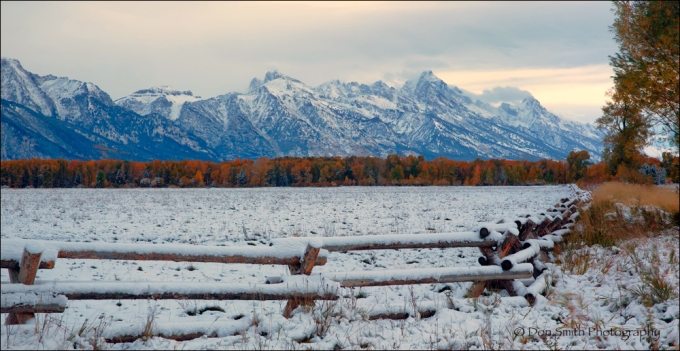
First Snow of the Year – Grand Teton National Park
Canon 5DMKIII, 24-70mmL II @ f/20, 2 second timed-exposure, ISO 200, Singh-Ray LB Polarizer
NOTE: Utah has taken control of their (9) National Parks and will fund them while Washington tries to figure things out. I’m off to Moab today for my Arches/Canyonlands Workshop!
When one lives in “sunny” California as I do, it’s easy to get excited about fresh snow! On my recently completed Fall in Grand Teton Workshop(s), we had multiple mornings of fresh snow for our groups to photograph.
While I taught during the day, my two assistant instructors, Scott Schilling and Pierre Steenberg, drove endless miles searching for shooting locations. They found this idyllic scene near the Jackson Hole Ski Resort and when we awoke to fresh snow and a clearing storm, we loaded up the group and made a beeline for this location.
Upon arrival, my first thought was, where are all the other workshop groups and local photographers? Another group did arrive about 45 minutes later but for some strange reason, decided to shoot towards the east and away from the beautiful snow-covered Teton Range.
Scott and Pierre had found this intriguing fence (always thinking foreground objects) to help add a layer of depth to the scene. Similar to a well-composed song, compositions (both musical and visual) build on depth.
I was in the gym the other day and the song, Viva La Vida, by Coldplay, came on my iPhone. I really like this song and noticed how each verse musically built (or layered) on top of the previous. Finally, by the time the chorus came around, all the instruments were fully engaged.
Depth in a visual medium like photography is also important to creating successful images. Photography is a two-dimensional medium but there are ways to add the “illusion” of depth. Let’s take a look at some techniques I teach and use in my own photography.
Highlight / Shadow (Japanese artists call this Notan)
Leading Lines
Perspective Control
In-Focus vs Out-Of-Focus
Stopping Eye Leaks
In the book, Understanding Composition :: Understanding Line, Notan and Color, author Arthur Wesley Dow explores the movement of the viewer’s eye via line, color, and oscillating black-and-white tones (Notan). The use of dark vs. light tones is one of the ways to move the eye and build depth in your image. In the image above, we start with a light layer (foreground snow), then add a dark layer with the fence, which in turn moves the eye to the meadow (light), then back to dark with the line of cottonwoods and evergreens, then back to light (Teton Range), and finally dark again (storm clouds in sky). Remember, light tones move towards the viewer while dark tones recede.
Line movement is also a way to help move and guide your viewer’s eye. There are Real lines (such as this fence and the horizontal created by the trees, and Implied lines (think about a row of rocks in a stream for example). Studies have shown that the brain will fill in the missing information and complete the line. I’m always on the lookout for similar objects in nature that can create an implied line if real lines are not present.
The next example is perspective control. Most of us (myself included) make the mistake of setting the tripod to our eye-line (I’m 6’2″). What this did for the image above was placed a lot of the meadow (which wasn’t that interesting) in the frame. By lowering the tripod and camera, I could control how-much or how-little of the meadow appeared in my composition. I felt this perspective (the camera was about waist high) was just right (it was a feeling and not a mathematical formula – trust your feelings). By lowering my position to the fence line, I in-turn pushed the fence line higher in my composition. In my first try (at 6’2″) the line was too low allowing for too much of the meadow to occupy my frame. I tell my students to be aware of how much “real estate” each element in your frame occupies. There has to be a good reason for allocating space to every element. Sometimes it just “feels right,” but at least think it through and question yourself as to why?
Another way of directing the eye and producing depth is through the creative use of what is in-focus as opposed to what is out-of-focus. We can do this through either using a larger (or smaller) aperture, and/or using a telephoto lens. After I set my ISO and my composition, my first question is always, “what aperture should I use.” For this scene, I needed sharpness from foreground to infinity; thus, I used a wide-angle less and a very small aperture of f/20 (f/16 was not quite enough). This allowed my hyperfocal point to be 30 feet from the camera (there are many smart phone apps that allow you to calculate this), and my image was razor sharp!
My last thought, after I have set my shutter speed (thankfully there was no wind on this particular morning), is to allow my eye to drift around the perimeter of the frame and check for either distractions, or what I like to call, “eye leaks.” These are areas around the edges of the frame where generally a line or a hot (overexposed) part of the image will draw or lead the eye out of the scene. It can happen in any layer of your image, so pay careful attention. Eye leaks are a way to ruin image depth because they allow the eye to escape the frame.
When it all comes together, it’s like the chorus of a great song, I trip the shutter and my image is full of depth and contains my viewer’s visual interest!
2013 Photo Workshops
2014 Photo Workshops
3rd Annual Fall Color in Grand Teton National Park – September 23 – 27, 2014 (5 spots remaining)
Software Discounts
Photomatix Pro 4.2 type in code at checkout: donsmithphotography 15% discount
Topaz Software type in code at checkout: SMITHPHOTO 10% discount
Helicon Focus click on link to receive 15% discount
Hardware Discounts
Special September Offer From Think Tank Photo NOTE: (Use Promo Code WS-643)
Gura Gear – 5% Discount – Use Promo Code DSMITHPHOTO
Purchase Fine Art Prints and Cards
Click on this link to purchase prints and cards from a growing library of my favorite landscape images:
Category: Landscape Photography Tagged: 2014, Grand Teton NAtional Park, Grand Teton Range, photo workshop, Wyoming
To Find Your Image – First Find The Light
Posted on October 10, 2013
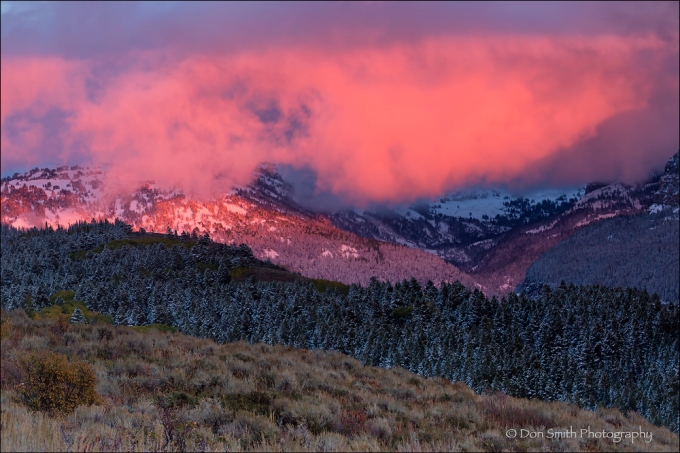
Mountain Light, Alta, Wyoming
Canon 5DMKIII, 135mm, f/16, 2 1/2 seconds, 100 ISO, Singh-Ray CC Polarizer, Singh-Ray 2 stop soft-edge GND
One of my favorite color landscape photographers of all-time was the late-Galen Rowell. I joke that I have read his classic book Mountain Light 11 times (true story)! I highly recommend his book to any of you who are really serious about your craft.
Rowell taught me a lot (though I never took a workshop) via his writings. I had the opportunity to meet him once in his gallery in Bishop, California. He and his wife’s passing was tragic – a great talent lost.
Personally, I’ve tried to incorporate many of Galen’s teachings into my own work. One concept he continually taught was to first find the light. One of his famous quotes was, my first thought is always of light.
On a recent location shoot with my second Grand Teton Workshop group, we drove above Alta, Wyoming (below Grand Targhee Ski Resort) for a late-afternoon fall color shoot, then ended-up about two miles below the ski resort for our sunset shoot.
I saw these clouds hanging around Grand Teton Peak. Scott Schilling and Pierre Steenberg had scouted this location earlier in the day as Grand Teton National Park was closed to our group due to the government shutdown. Both were bemoaning the fact that the peak(s) was not in view as they had been earlier in the day.
As the old saying goes, when life throws you a lemon… Well, life has been throwing me quite a few lemons these days, but we had driven over an hour to get here, and the Lemonade was going to be this incredible light.
As best I could, I alerted everyone in the group to anticipate this light. We could see a clearing to the west. Almost on cue, the sun slipped down below the last cloud bank behind us and the show began. The color palette ranged from warm sunlight painting the scene to deep orange and finally these vibrant warm pinks/reds illuminating just the cloud and the top section of the snow-covered hill. In fact, this was my last frame of the evening before the light fell off the cloud. You can see the shadow not only working up the snow-covered evergreens, but also coming down from the top of the frame.
From a technical standpoint, the wind was blowing, and because I had chose to shoot this scene at 100 ISO, I neglected the fact that the wind would buffet my rather large 70-200mmL Series II f/2.8 lens as well as the usually staid rabbit brush. The resulting image was a bit soft. In retrospect, I should have bumped the ISO and went with a faster shutter speed. But for this image, I let technology come to the rescue!
In the past, I would have bypassed this image due to the motion softness; however, I am now processing with Photoshop CC and I decided to use the new Shake Reduction filter (Sharpen > Shake Reduction). It is an easy filter to use and I simply applied 5 Blur Estimation regions and the algorithms did the rest!
As you can see, this image amazingly sharpened. I simply applied a layer mask and deleted the sharpening affect from the cloud (clouds should be soft).
Under different light or minus the clouds, this scene would look completely different. Yet, by waiting and anticipating the light, my group was rewarded with a clearing storm image and beautiful Mountain Light.
This location (and the previous one) will stay permanently in the rotation for next year’s workshop. I only have 7 spots left. If you are interested in joining us, please click here: 2014 Fall Color and Mountain Grandeur, Grand Teton Workshop.
2013 Photo Workshops
2014 Photo Workshops
3rd Annual Fall Color in Grand Teton National Park – September 23 – 27, 2014 (9 spots remaining)
Software Discounts
Photomatix Pro 4.2 type in code at checkout: donsmithphotography 15% discount
Topaz Software type in code at checkout: SMITHPHOTO 10% discount
Helicon Focus click on link to receive 15% discount
Hardware Discounts
Special September Offer From Think Tank Photo NOTE: (Use Promo Code WS-643)
Gura Gear – 5% Discount – Use Promo Code DSMITHPHOTO
Purchase Fine Art Prints and Cards
Click on this link to purchase prints and cards from a growing library of my favorite landscape images:
Category: Landscape Photography Tagged: alta, cloud, Grand Targhee, mountain light, snow, sunset, Wyoming
For Best Light – Arrive Early And Stay Late!
Posted on October 7, 2013
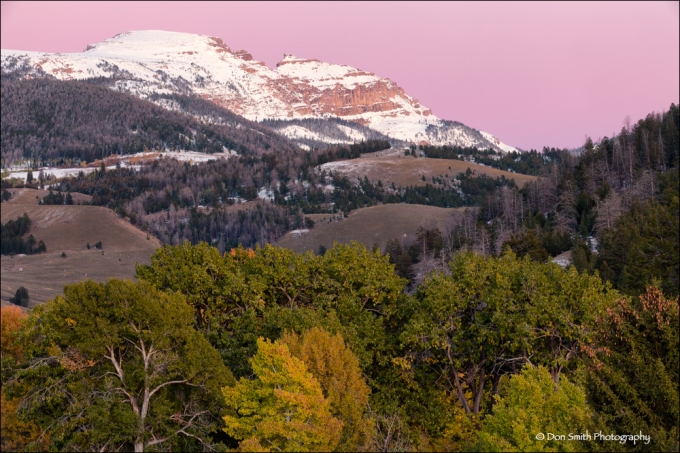
Dusk, National Elk Refuge, Jackson, Wyoming
Canon 5DMKIII, 130mm, f/16, 4 second timed-exposure, ISO 200, Singh-Ray Color Combo Polarizer
Having spent my entire life living in “sunny” California, I learned a long time ago about the importance of getting up early to be on location – sometimes as much as an hour ahead of time on clear days. Yes, that means very early wake-up calls and drives in the dark, but dawn light is simply amazing.
On the other end of the spectrum, I will not leave a location simply because the sun has set. Some of the best light, especially at higher elevations, can come and last well after sunset. My most recent blog post even talks about Capturing Alpenglow Light that happens early and late when the sun is not visible to the naked eye.
During my recently completed Grand Teton Workshops in Jackson, Wyoming, the government shutdown meant I could no longer take my groups into the park for location shoots. I heard reports of other groups violating that rule and getting away with it, but I plan on holding many more workshops there in upcoming years and abided by their rules. Besides that, there are legal and liability issues to deal with, and once the park closed, I sent my co-instructors (Scott Schilling and Pierre Steenberg) out to scout locations that included as much of the Teton Range, but from outside the park boundaries.
To say the least, they did a fantastic job and found locations every bit worthy as those we had lined-up for our group inside the park. Having not actually photographed these locations at sunrise/sunset times, I made sure we arrived at morning locations a minimum 45 minutes prior to sunrise. On the other side of the day, I made sure we stayed out well after sunset, until, the last ounce of color had flickered out.
On our last sunset shoot with Workshop group #2, we got a good lesson as to why we do just what I explained. We were shooting a sunset over the Teton Range on a very chilly evening. Long after the sun had set behind the mountains to the west, we turned around and were greeted with this incredible scene looking east. The sky was filled with purple and pink hues and the wind had died down enough to allow for a long shutter speed to capture the foreground cottonwoods.

Dawn Skies Over Grand Teton Range
Canon 5DMKIII, 95mm, f/16 (focus set with hyperfocal focus), 15 second timed-exposure, 200 ISO, Singh-Ray CC Polarizer
The next morning, we arrived in the dark at this location high above the valley floor. This allowed our participants to choose a foreground that would work with the Teton Range and add a sense of depth to the scene. Though headlamps were initially required, our eyes soon adjusted. I used my 70-200mmL lens to compress my foreground with the mountain range. Careful focus had to be applied to ensure sharpness throughout the scene. I used Essence Computing’s Focal – Depth of Field Calc app that I had on my iPhone to help set my hyperfocal focus point. As you can see, the focus did indeed hold from foreground to infinity (the mountains), and all I did was wait for the dawn light to warm the cirrus clouds with this beautiful pink color.
One of the other positive benefits of working under dawn and dusk light is that the contrast range is well within your sensor’s dynamic capture range – both of these images were captured in one frame, requiring no graduated neutral density filters or bracketed exposures.
My message for all of you is simple: get on location early and stay on location late. Your digital camera’s ability to capture photons that your eyes cannot see is simply amazing!
2013 Photo Workshops
2014 Photo Workshops
3rd Annual Fall Color in Grand Teton National Park – September 23 – 27, 2014 (9 spots remaining)
Software Discounts
Photomatix Pro 4.2 type in code at checkout: donsmithphotography 15% discount
Topaz Software type in code at checkout: SMITHPHOTO 10% discount
Helicon Focus click on link to receive 15% discount
Hardware Discounts
Special September Offer From Think Tank Photo NOTE: (Use Promo Code WS-643)
Gura Gear – 5% Discount – Use Promo Code DSMITHPHOTO
Purchase Fine Art Prints and Cards
Click on this link to purchase prints and cards from a growing library of my favorite landscape images:
Category: Landscape Photography Tagged: color, cottonwoods, dusk, evergreens, fall, Jackson Hole, National Elk Reserve, sky, snow peaks, Wyoming
Capturing Alpenglow Light
Posted on October 5, 2013

Early Morning Alpenglow on Grand Teton Range
Canon 5DMKII, 125mm, f,16, 4 second timed-exposure, ISO 200, Singh-Ray LB Polarizer, Singh-Ray 2 stop GND
We are in the midst of fall color in Wyoming and elsewhere in the country. Fall color photo workshops were scheduled at many National Parks. Then, at 12:01am Tuesday morning, the government effectively shut-down along with all 59 National Parks.
I’ve heard many stories from various blogs and other photographers about how various parks are handling the shutdown. Some are allowing groups to shoot, and some, like Grand Teton National Park, are not. I’m a Commercial Use Authorization (CUA) holder with the park and have abided by their rules to stay out. But I continuously hear stories of workshop groups entering the park and setting their groups up for sunrise and sunset shoots with no consequences. Granted, their are only a handful of rangers left on duty and they can’t be everywhere at once, but it seems this is still happening.
I was fortunate in that I had two awesome assistants with me, Scott Schilling and Pierre Steenberg. They scoured every square inch of the surrounding Jackson Hole area and came through with some amazing locations (we even drove into Idaho to get on the back side of the Teton Range one late afternoon/evening).
This image was from a very early morning shoot (temperature was a chilly 19 degrees) where we got alpenglow light on the peaks from the National Elk Refuge east of Jackson. Grand Teton Peak, the tallest in this scene, is just a shade under 14,000 feet. Alpenglow (from German: Alpenglühen) is an optical phenomenon in which a horizontal red glowing band is observed on the horizon opposite to the sun – in this case, the Teton Range.
Due to a phenomenon called light-scatter, all the cooler colors of the light spectrum are scattered as the sun’s rays bend up and over the horizon.
This effect occurs when the sun is just below the horizon. Alpenglow is easiest to observe when mountains are illuminated but can also be observed when the sky is illuminated through backscattering.
Since the sun is below the horizon, there is no direct path for the light to reach the mountain. Instead, light reflects off airborne snow, water, or ice particles low in the atmosphere. These conditions differentiate between a normal sunrise or sunset and alpenglow.
Although the term may be loosely applied to any sunrise or sunset light seen on the mountains, true alpenglow is not direct sunlight and is only observed after sunset or before sunrise.
The alpenglow light you see on this image arrived 6 minutes prior to posted sunrise (sunrise from our position was 7:29am and I captured this image at 7:23am). The look is this intense red painting the mountain peaks and snow. It comes and goes quickly and one must ready. To balance the foreground cottonwoods with the light on the peaks required the help of a Singh-Ray 2-stop hard edge graduated neutral density filter (which I jigged during the 4 second exposure to blur the transition line).
Once direct sunlight hit the peaks, the warm alpenglow light disappeared and was replaced by a more neutral light. To ensure one captures alpenglow light means arriving on location at least 30 minutes prior to posted sunrise time. Our group was on location for this scene 45 minutes prior.
Alpenglow is most pronounced in the high mountains. It requires getting out of bed early to capture it in the morning; and conversely, staying our past sunset. It’s just a little extra time but the results are amazing. Give it a try the next time you are in the mountains.
2013 Photo Workshops
2014 Photo Workshops
Software Discounts
Photomatix Pro 4.2 type in code at checkout: donsmithphotography 15% discount
Topaz Software type in code at checkout: SMITHPHOTO 10% discount
Helicon Focus click on link to receive 15% discount
Hardware Discounts
Special September Offer From Think Tank Photo NOTE: (Use Promo Code WS-643)
Gura Gear – 5% Discount – Use Promo Code DSMITHPHOTO
Purchase Prints and Cards
Click on this link to purchase prints and cards from a growing library of my favorite landscape images:
Purchase Fine Art Prints and Cards
Category: Landscape Photography Tagged: alpenglow, clouds, cottonwoods, fall color, fog, Grant Teton Range, Jackson, National Elk Reserve, Wyoming
Dealing With A National Park Shutdown
Posted on October 2, 2013
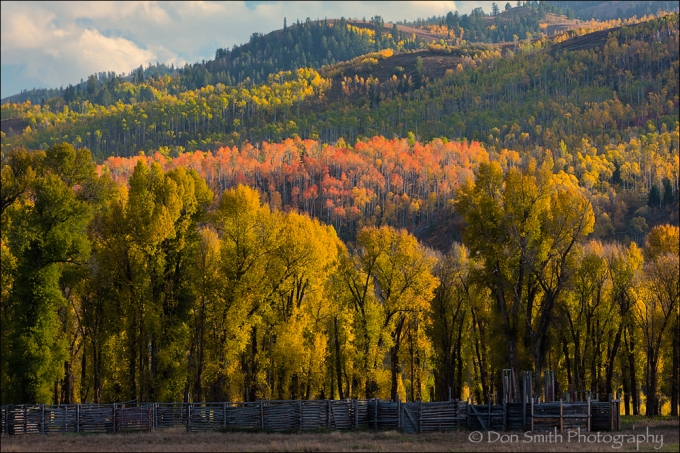
Aspen Glow, South Park Wildlife Habitat Management Area, Jackson, Wyoming
Canon 5DMKIII, 168mm, f/16, 1/50th, ISO 800, Singh-Ray LB Polarizer
I am in the middle of two Grand Teton National Park fall workshops. One small problem – I no longer am allowed to teach in the park due to the government shutdown. Essentially, all 59 National Parks in our country have fallen victim to the idiocy that is happening in Washington D.C.
As a workshop leader, I am required to have a Commercial Use Authorization permit for the parks I teach in. I have no trouble with this; in fact, I support paying for these permits. It helps keep legitimate workshop leaders above board.
Two days ago I was told by the ranger who oversees the CUA’s, that if the government did indeed shut down, that the main highway through the park (Highway 89), would remain open, and she thought that all the overlooks along with the famous Moulton Barns on Mormon Row would also be available for our group. Yesterday I was part of a conference call where park officials told use we had to immediately cease operating anywhere in the park.
I was extremely fortunate to have my assistant instructor, Scott Schilling, and long-time friend, Pierre Steenberg, begin an all-out scouting search of the greater Jackson area while I taught our workshop classes. The two of them worked tirelessly and came up with 11 locations that will assist me and my students in having some wonderful areas to photograph. We have already photographed with the group at three of them.
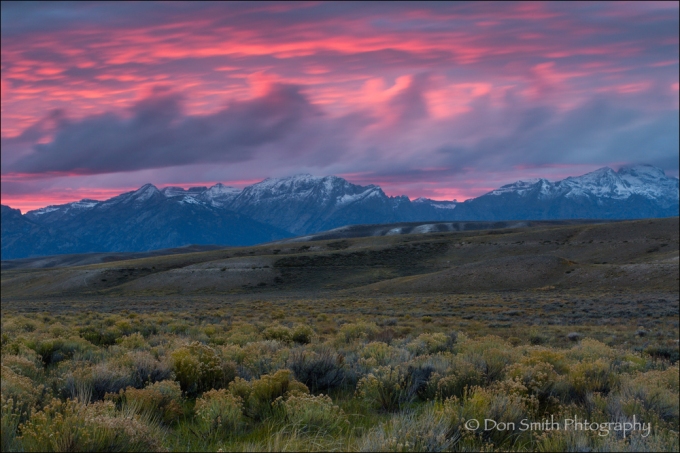
Mountain Light, National Elk Refuge. Grand Teton Range.
Canon 5DMKIII, 70-200mmL @ f/22, 13 seconds, 100 ISO, Singh-Ray LB Polarizer, Singh-Ray 2 stop GND
On top of dealing with no park access, we now have two winter storms bearing down on us. We photographed fall color in light rain today until heavy rain finally arrived. Outside my window, it is starting to turn to snow. Four to six inches of the white stuff is forecast to arrive tomorrow. I told my students that if we can’t shoot, we will have class training. Skies are supposed to clear on Friday. If the snow is manageable, we will be smack in the middle of it tomorrow – sadly, just not inside Grand Teton National Park.
We held out hope that something would happen with the shutdown late this afternoon as the President met with both House and Senate leaders, but as you all know, the shutdown is still in effect.
Because we have scouted endlessly for three straight days (Pierre and Scott will be out again tomorrow), we can confidently run our workshop and provide quality locations once the nasty weather breaks.
Grand Teton National Park ranks right up there with the best and most scenic of all our National Parks. It’s a shame, especially in the height of the fall color season with fresh snow now falling, that we cannot access it – even though we have paid for the permit.
Washington’s stubbornness is frustrating but we have worked hard to overcome it. I just hope for all the citizens of our country, this insanity ends soon. As for my workshop students, we have some stunning locations in store for you!
2013 Photo Workshops
2014 Photo Workshops
Software Discounts
Photomatix Pro 4.2 type in code at checkout: donsmithphotography 15% discount
Topaz Software type in code at checkout: SMITHPHOTO 10% discount
Helicon Focus click on link to receive 15% discount
Hardware Discounts
Special September Offer From Think Tank Photo NOTE: (Use Promo Code WS-643)
Gura Gear – 5% Discount – Use Promo Code DSMITHPHOTO
Purchase Prints and Cards
Click on this link to purchase prints and cards from a growing library of my favorite landscape images:
Purchase Fine Art Prints and Cards
Category: Landscape Photography Tagged: clouds, dusk, Grand Teton NAtional Park, Jackson Lake, Wyoming
When Seasons Collide :: Beautiful Becomes Spectacular
Posted on September 27, 2013

Fall color and Grand Teton Range after clearing storm.
Canon 5DMKIII, 30mm, f/16, 1/20th, Singh-Ray LB Polarizer, Singh-Ray 2-stop soft edge GND, Lexar Digital Media
It’s hard for me to wrap my mind around the fact that just two weeks ago I was basking in the balmy tropical breezes of Hawaii’s Big Island. Yesterday, I stepped off the plane at Jackson Hole, Wyoming and was immediately thrust into frigid winter conditions. “Where in the heck did fall go,” I thought to myself.
Light snow flurries and a stiff breeze greeted me as I walked towards the terminal. A frozen-looking airport employee told me she was not ready for this type of weather so early in the season. The dismayed look on her face told me that she was not kidding.
I could see the Teton Range slowly emerging from the clouds and knew I may have a window of opportunity to capture two seasons in one. The fall color here in Jackson Hole is at what I would consider nearing peak. Some cottonwoods have already leafed-out while others (along with some aspens) are just now starting to turn.
I am here for the next 11 days teaching two fall color workshops. Our bonus, at least if the temperatures stay relatively cold, it that the Teton Range, spectacular regardless of the season, is covered in snow 2/3rds of the way up.
After I picked-up my rental car and checked in to the hotel, I immediately grabbed my camera gear and headed into the park. Fortunately the clouds were still lifting and the peaks were in full view covered in snow. One of my first stops was near Moose Junction. After composing some grand scenes, I became a bit dismayed as I noticed clouds starting to envelope the range once again.
I decided to wait things our but the snow became heavier. My goal was to stay close to the range in the hopes that the clouds would again break. Soon after entering the south entrance gate along Grand Teton Road, I came across this scene that I have always liked. Much to my surprise, the snow flurries subsided and the clouds did indeed lift, leaving me with this incredible scene of fall color and dramatic peaks of the main portion of the Teton Range.
The soft light made the exposure very easy (I did use a 2-stop soft edge grad to hold down the bright parts of the sky), but other than that, I just worked the scene for various compositions. What was even more incredible was the fact that no other photographer was there – I had this all to myself.
Grand Teton National Park is quickly becoming one of my favorites of all the National Parks. Add some fresh snow and fall color, and it becomes a spectacular site.
It was snowing again this morning when I met up with my long-time neighbor Ali. She has been living in Moose for the past four months and had some out-of-way locations to show me. To say the least, they were incredible and I will use them as part of the workshop – thanks Ali The forecast for the next five days is trending towards more normal conditions with warmer fall-like weather. Conditions couldn’t be more perfect. Workshop #1 begins tomorrow!
2013 Photo Workshops
2014 Photo Workshops
Software Discounts
Photomatix Pro 4.2 type in code at checkout: donsmithphotography 15% discount
Topaz Software type in code at checkout: SMITHPHOTO 10% discount
Helicon Focus click on link to receive 15% discount
Hardware Discounts
Special September Offer From Think Tank Photo NOTE: (Use Promo Code WS-643)
Gura Gear – 5% Discount – Use Promo Code DSMITHPHOTO
Purchase Prints and Cards
Click on this link to purchase prints and cards from a growing library of my favorite landscape images:
Purchase Fine Art Prints and Cards
Category: Landscape Photography Tagged: clearing storm, fall, fall color, first snow, Grand Teton NAtional Park, Wyoming
Filters: You’ve Got Questions? We’ve Got Answers!
Posted on June 15, 2013
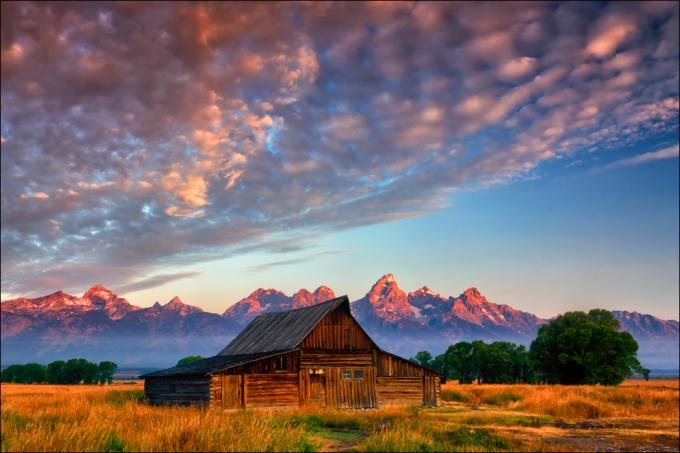
Moulton Barn and Sunrise Light on Grand Teton Range
Canon 1DsMKIII, 24-70mmL @f/16, 1/6th second, 200 ISO, Singh-Ray LB Polarizer, Singh-Ray 2 Stop soft-edge graduated neutral density filter
In my role as a landscape workshop instructor, I am asked a lot of questions – goes with the territory. In fact, I get on average, 20 emails per day with questions from both past and present workshop students and from many people I’ve never met asking for advice ranging from, what camera should I buy, to, can you explain the Inverse Square Law (kidding – but it could happen)!
Without a doubt, the number one question I get involves filters for landscape photographers. Before I even discuss which filters to use, I look at what brand of filter to use. I am a huge fan of Singh-Ray filters because of their quality and color-neutral construction. Like anything in life, you get what you pay for. Yes, Singh-Ray filters are expensive, but if treated well, they will last you a lifetime. I have also heard good things about Lee Filters but I have no personal experience. I have heard/read that Lee’s grad densities are not as precise as Singh-Ray, but I have no conclusive tests to prove this.
As for the question: What kind of filters should I buy?, there really are two: a good polarizer (which cannot be replicated in post-production) and some grad filters. If you wish to play with motion, think about adding a neutral-density or variable ND filter.
Let’s take a look at some other important questions:
What graduated neutral density filters should I purchase?
When asked this question, my advice for a good starter set is a 3 stop hard-edge and a 2 stop soft-edge. I am an advocate of hand-holding the filter during exposure and keeping a slight movement with the filters to ensure a smooth transition line. If you are using Singh-Ray filters, you can even stack these two filters together to get 5 stops of graduated neutral density!
Should I use a filter holder or handhold?
This is really your call; however, as I mentioned above, I have done away with filter holders for three reasons: a.) I can keep the filter moving a bit during the exposure, b.) I no longer have issues with vignetting caused by the holder, and c.) I can work fast – especially important in the rapidly-changing light found around the fringes of the day.
But I still want to use a filter holder. What one should I use?
The best advice may be to take your camera/lenses to your local camera store and test the various holders available. It’s important to test using small apertures (f/16 and f/22) as these are the f-stops when vignetting rears its ugly head. Take a look at either a Cokin Z-Pro or Lee holder. I used to use a Cokin but had to saw off the front holder slots. Vignetting is most common with focal lengths of 24mm and less. Also, you can try gaffer tape (a non-residue tape available at pro camera stores) and just tape the edges of your grad to the lens barrel.
What are filters made of?
The best grad filters (including Singh-Ray) are made with high-quality optical resin, the same material used in prescription eyeglasses. Ring-mounted filters (polarizers, nuetral density, and variable neutral density filters) are made of glass.
Are filters multi-coated?
Singh-Ray filters are not. According to the company, after careful evaluation of multi-coated filters, and in our opinion, the benefits are negligible, and outweighed by several disadvantages.
What about scratched filters?
Most scratches will not affect the quality of your images whatsoever. When you hold a filter in front of your lens, your focus point is well past the actual filter itself (anywhere form a few feet to a couple hundred yards). According to Singh-Ray, your filter has to have a pretty severe scratch, or a lot of light scratches, before you experience problems with your filter. The only way to know for sure is to test shooting a scene with and without the filter, then evaluating on a good monitor with the image enlarged to at least 100%.
What is the best way to protect my filters?
I used to use the pouches that each filter came in from Singh-Ray. While on a shoot in late 2010, I became overwhelmed with the amount of filters I owned and discussed this with Singh-Ray’s Weir McBride. He in-turn put me in touch with with a Utah company called Kinesis Photo Gear and with my input, the F169 Large Grad Filter Pouch was developed. Here is an article I wrote for Singh-Ray blog.
I’m getting a color cast with my Neutral Density Filter. What’s the problem?
I will defer to the experts at Singh-Ray for this answer: When using a Neutral Density filter (graduate or solid) you are generally causing your camera to make a longer exposure than normal, sometimes much longer. The software in some digital cameras uses response curves that adjust the RGB sensors sensitivity based on the exposure time, which may introduce more red into the image. Sort of a digital form of reciprocity failure. In other instances, blocking visible light and a longer exposure allows infrared light to “build up” on the red sensors leading to a red or purplish cast.
What’s the difference between a ND Grad and a Reverse ND Grad?
Graduated neutral density filters are designed to transition from light to dark in terms of stops of light. For example, a 3 stop soft-edge GND would be reveal the full three stops of ND at the top of the filter and would transition down to neutral (no ND) at the mid-point of the grad. A Reverse ND grad is a specialized version with the darkest area is in the center of the filter and transitions to about 1 stop lighter at the top of the filter. These filters are fantastic to use at sunset times with a flat horizon (I had success with mine at the ocean and Grand Canyon). They are made in both 3 and 4 stops.
I have a 14-24mm f/2.8 Nikkor lens or similar designed lens with a bowed front element. What filters can I use?
I also own this lens (yes I am a Canon shooter but I use a Novaflex adapter). I use a Fotodiox 145mm polarizer and holder. It is large but it does fit into my camera bag and is the best setup that I have found.
Hopefully this answers your filter questions. If you have any questions that I did not address here, send me an email. I do make a point of answering all emails – just have some patience!
2013 Photo Workshops
2014 Photo Workshops
Software Discounts
Photomatix Pro 4.2 type in code at checkout: donsmithphotography 15% discount
Nik Software type in code at checkout: DSMITH 15% discount
Topaz Software type in code at checkout: SMITHPHOTO 10% discount
Helicon Focus click on link to receive 15% discount
Hardware Discounts
Think Tank Photo (Receive a free gift for any order over $50 when you order using this link!)
NOTE: Use Promo Code WS-643
Purchase Prints and Cards
Click on this link to purchase prints and cards from a growing library of my favorite landscape images:
Purchase Fine Art Prints and Cards
Purchase Fine Art Prints and Cards
When Sometimes Just Showing Up Is Enough
Posted on September 28, 2011

Canon 1DsMKIII, 24-70mmL @ f/16, 1/6th second shutter, 200 ISO, Singh-Ray Circular Polarizer, Singh-Ray 3 -top soft edge GND, Lexar Digital Media
When one visits Grand Tetons National Park, it is almost a given that at least one stop, usually timed for sunrise, will be made at one of the Moulton Barns along the Mormon Row Historic District. We’ve all seen this location photographed millions of times, but what the heck, it is an awesome scene to behold. I really anticipated a hoard of photographers when my friend Mike Hall and I departed our hotel in Jackson during the pre-dawn darkness for the 20-minute drive out to the historic barn. Much to our surprise, there were only two other shooters, though more did arrive after us but missed this incredible light. As we arrived at the break of dawn, the clouds you see in this image were to the left and barely visible along the left edge of my composition. We had checked out this scene the day prior and I realized that I would like to position the apex of the barn just to the left of Grand Teton Peak (elevation 13,775 feet). Much to my surprise, neither of the other two photographers had thought about this (fortunate for me) or they simply had different compositions in mind. Positioning the apex of the barn anywhere else allowed for the ridgeline of the barn to block the outline of the Teton Range (a subrange of the Rocky Mountains that extends from southern Alaska to northern New Mexico). This also held true for my point of view. Had I lowered the tripod, the roof of the barn would have risen and also blocked the outline of the mountains.
As we eagerly awaited the warm alpenglow to hit the ridge of the Teton Range, we saw that the clouds were slowly drifting into our frames. I have totally no knowledge of prevailing morning winds in this location but really had to pinch myself for being this lucky! As you can see, as the diffused alpenglow (caused by a multitude of wildfires in nearby eastern valleys) lit the range, most of the stratus clouds had drifted overhead and caught the warm light of the approaching sun (which had yet to crest the eastern horizon). How perfect was that? Reminds me of my favorite Ansel Adams quote: Sometimes I do get to places just when God’s ready to have somebody click the shutter. I don’t wish to get into religious preferences here, but I often feel that a higher power is grabbing me by the neck and saying, Hey dummy, look at this!
This brings me to the meat of this post. I feel (myself included) that we all get too caught up in making the perfect image – to the point that sometimes we need to take a breath and just drink in the beauty that surrounds us. I have to credit my friend Gary Hart with jolting me with this reality as once on a workshop I was stressing because I didn’t like the way I was capturing a scene. As I recall, it was an early morning shoot on some frozen mountaintop with unbelievable light when suddenly Gary called out for the group to just take a moment and appreciate what was happening in front of us. Really now, isn’t that why most of us got into landscape photography to begin with? Didn’t you at one time in your life experience some cool moment in nature only to look around and realize you were it – not one other person on the planet at that particular place in time bared witness to what just moved your soul? Wasn’t that an epiphany moment when you realized a camera would have helped you capture that moment (and feeling) forever to share with friends and family? I know it happened to me early in my life as I practically was brought up on a pair of skis. Some of the incredible mountain scenery and light I witnesses was amazing, it is what got me to pick up a camera.
It’s somewhat unfortunate that we photographers tend to get into a competition with each other. I hear comments all the time: My shot was better than hers; I liked my angle better; that’s a good image but the light is wrong; and perhaps my favorite: why did you use that lens? On my last post some guy was angry enough to write in and rip me a new you know what – for what – posting an image of nature that he didn’t like? It’s crazy if you ask me. Of all the different types of photography I have tried – from corporate, wedding, sports, portraiture and landscape, I find nothing more soothing to my soul then standing in front of an incredible scene such as what I have posted today. I remember not sleeping well and feeling tired, I was a bit cold, and I was hungry! And oh yeah, I would have killed for my Starbucks right about then! But then this scene unfolded under this incredible light and suddenly my soul was uplifted. I instantaneously felt small and insignificant in light of what was unfolding around me. I instinctively held my GND filter up to my lens and began the process of capturing this scene. Basically I was in heaven as my friend Pastor Pierre likes to say!
At that point in time, I, and only a handful of others, were witnessing a gift handed to us by someone more in control than me. I don’t remember hearing anyone talk – heck, I don’t even remember shutters clicking. A unique image? No. As I wrote earlier, I’ve seen million of images captured from this location. But what makes this unique for me, is that this image, this moment in time, this experience with nature, was mine. But the more important question for me would be: Would I have enjoyed this sunrise even without a camera? Believe it or not, I would have – it was that beautiful. It’s moments like this that constantly remind me that oftentimes the experience is better than the image. It was my camera and my love for photography that brought me to that particular location at that early hour of the day. But when the moment passed, when the sun began to flush the entire scene with light, when the warm hues on the clouds turned neutral, I suddenly felt alive, warm, filled, and most importantly emotionally stirred with the gift nature just gave me. Indeed, sometimes showing up is truly just enough.
Category: Landscape Photography Tagged: fall, Jackson Hole, Mormon Rwo Historic District, Moulton Barn, sunrise Grand Tetons, Wyoming
Recent Posts
- Why I Will Never Fly American Airlines Again :: At Least Not After Next Tuesday…
- New Blog Site For Don Smith Photography!
- Do You Look Or Do You See? Developing Your Creative Vision :: Part 2 of 3
- Do You Look Or Do You See? Start With 10,000 Hours Of Practice :: Part 1 of 3
- Photographing Wildflowers In The Wind At Big Sur’s Garrapata State Park
